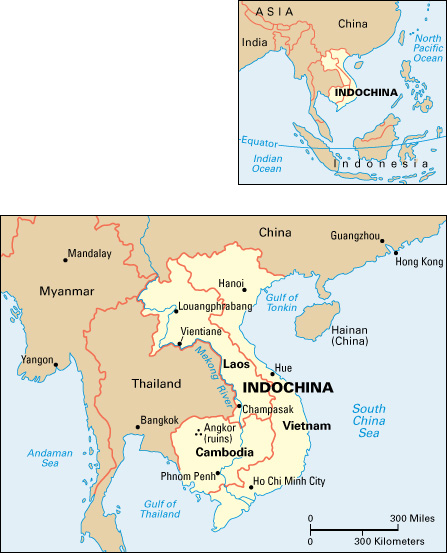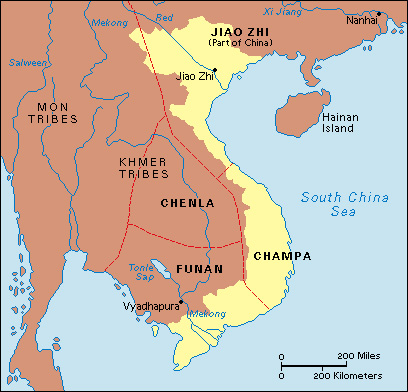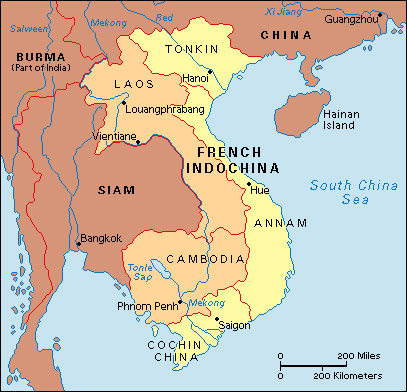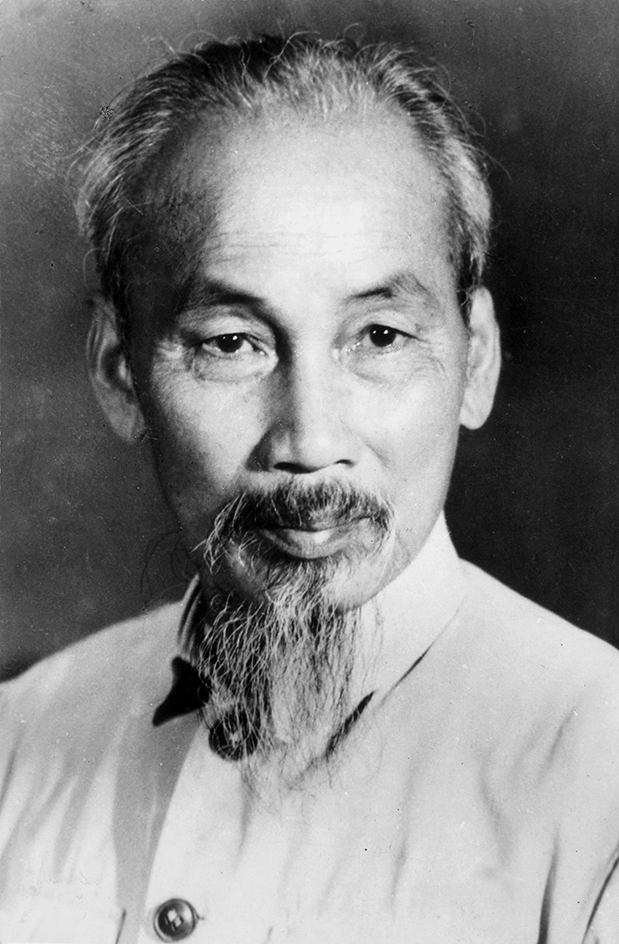Indochina is the eastern half of a long and curving peninsula that extends into the South China Sea from the mainland of Southeast Asia. Indochina consists of the three nations of Cambodia, Laos, and Vietnam.

Indochina has long been a crossroads of peoples and cultures. It has been invaded from what is now Thailand on the west, from China on the north, and from the sea on the east. Most of the people of Indochina originally came from the plains and mountains of central Asia and from southern China. Some of the earliest settlers came from the islands now part of Indonesia. Over the centuries, the crisscrossing moves of many groups have created a checkerboard of ethnic and language groups. The people have never been able to develop much unity or uniformity among themselves.
Independent peoples and states once made up the area. From the 900’s to the 1700’s, China and Thailand fought for control of Indochina. France gained control of the region in the 1800’s and held it until the 1950’s. The French called the region French Indochina.
This article deals with Indochina from its beginning until the Geneva Accords—or Geneva Agreements—of 1954, which brought French colonial rule in the region to an end. For details on developments in this region since 1954, see Vietnam War and the History sections of Cambodia; Laos; and Vietnam.
Early days
When the peoples of southern China and the northwest sections of the Indochina peninsula moved southward, they encountered a mixed Indonesian-Malay population. The two groups fought. In most areas, the Indo-Malays were forced into the mountains as the invaders took the more desirable areas along the rivers.
The Viets
moved into the peninsula from the coastal plains of southern China. A number of small states developed in the delta of the Red River in what is now northern Vietnam. By about 200 B.C., these states had united to form the kingdom of Nam Viet. In 111 B.C., the Han Empire of China seized control of the area. The Chinese called it Jiao Zhi. For the next thousand years, Vietnam was part of imperial China.
Tai people probably started moving from southern China across the northern part of Southeast Asia from about the A.D. 700’s. They conquered the Indo-Malay people, whom they called Kha, a Tai word for slave or savage.

The Khmer
people entered what is now Cambodia about A.D. 100. They claimed the peoples of India and China, as well as the Indo-Malay, as ancestors. They are the ancestors of the present-day Cambodians. The Khmer ruled most of Indochina, from the Gulf of Thailand to China, between the 800’s and 1400’s. Their empire was famed for its art, architecture, and government. The ruins of its capital, Angkor, still stand.
In 939, during the reign of the Khmer, the Vietnamese regained their independence from China. The Chinese had renamed the country Annam (Pacified South) in 679. The Vietnamese resented the name. They revolted and freed their country. They called the new state Dai Co Viet (Great Viet State). Although free, it had to make regular payments to China to keep the peace.
A new kingdom.
The Khmer began to lose their power in the 1300’s. In 1353, the kingdom of Lan Xang (the million elephants) was established in what is now Laos. It was set up by a Lao noble, Fa Ngum, who had fled to Cambodia as a boy and had been living in Angkor. Fa Ngum and his successors united several small Tai principalities (territories ruled by a prince) along the Upper Mekong River into a single state. Over the next century, Lan Xang developed an effective government and military organization. It also developed trade with its neighbors. About 1700, quarreling among powerful groups in the country destroyed its unity. It split into three principalities—Champasak, Vientiane (also spelled Vieng Chan), and Louangphrabang (also spelled Luang Prabang).
The Thai (formerly Tai), Vietnamese, and Burmese invaded the three countries many times during the 1700’s. By the early 1800’s, Siam (now Thailand) had gained control over the three kingdoms, including all of what is now Laos. The Thai and Vietnamese also took parts of the old Khmer empire until by the mid-1800’s it was approximately as Cambodia is today. A new dynasty (line of rulers) came to power in 1802 on the coast of eastern Indochina, where Dai Co Viet—then called Dai Viet—had been independent for about 900 years. It called its kingdom Vietnam. It began the modern history of the area.
French Indochina
French influence
began to develop in Indochina during the 1800’s. French missionaries had been very successful in converting Vietnamese to Roman Catholicism. Their successes brought occasional reactions from the Vietnamese emperors. In 1858, Emperor Napoleon III of France sent an expedition to avenge the murders of some missionaries and gain a foothold.
France forced the Vietnamese to give up parts of Cochin China (southern Vietnam). Through treaties between 1874 and 1884, France set up protectorates in Tonkin (northern Vietnam) and Annam (central Vietnam). Cochin China became a French colony.
Meanwhile, France had occupied what is now Cambodia in 1863 and set up a protectorate. In neighboring Laos, in the late 1880’s, French forces confronted Thai forces that had moved into Louangphrabang. In 1893, Siam was forced to sign a treaty that recognized French control over most of what is now Laos. Louangphrabang became a French protectorate, and Champasak and Vientiane formed a French colony.

World War II.
When World War II started, the situation in French Indochina changed greatly. On June 22, 1940, France surrendered to Germany. Japan took advantage of France’s defeat by moving forces into Indochina. The Japanese let the French remain in office as puppet rulers. Then, in March 1945, they interned (confined) all French authorities and military units.
During the war, Japan persuaded Vietnamese Emperor Bao Dai to declare Vietnam independent and to organize a government friendly to Japan. King Norodom Sihanouk declared Cambodia independent. King Sisavang Vong did the same for Louangphrabang.
Independence.
After Japan surrendered on Sept. 2, 1945, the French tried to return to power. In Vietnam, Chinese Nationalist troops accepted the Japanese surrender in the zone north of the 17th parallel. British troops disarmed the Japanese in the southern half of the country. France persuaded King Sisavang Vong of Louangphrabang to declare himself king of a self-governing Laos. France also regained control of Cambodia, and made it self-governing. Both Laos and Cambodia became members of the French Union.
However, another independent government was organized at the same time in Vietnam. This new ruling group was called the Democratic Republic of Vietnam. It was led by a Communist-trained nationalist, Ho Chi Minh, then head of the Revolutionary League for the Independence of Vietnam (Vietminh). French and Vietminh leaders tried to settle their differences peacefully, but failed. In December 1946, war broke out.

The French kept control of the cities in Vietnam, but were never able to regain power in the countryside. By the end of 1953, France was near defeat. When the Vietminh captured the great fortress of Dien Bien Phu on May 7, 1954, after a 56-day siege, it was clear that the war was almost over. See Dien Bien Phu, Battle of.
The Geneva Accords
From May to July 1954, Vietminh and French officials held meetings with representatives of the United States, the United Kingdom, China, and the Soviet Union in Geneva, Switzerland. The meetings resulted in the Geneva Accords. These agreements included a cease-fire that ended the war, which is sometimes called the First Indochina War. The agreements provided for the independence of Vietnam. They also confirmed the independence of Cambodia and Laos, which had been recognized as independent in 1953. As a result, French Indochina ceased to exist. The agreements also provided that Vietnam be temporarily divided into North Vietnam and South Vietnam, at the 17th parallel, and called for national elections in 1956 to unify the country. But the elections never took place. North and South Vietnam became divided politically, which provided the basis for the Vietnam War (1957-1975). That war is sometimes called the Second Indochina War.

